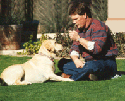|
Home Health Exams
Two weeks ago, I took my puppy to the vet to be neutered. As we arrived at the hospital, one of the receptionists began rubbing "Tug" under the chin and found a "button tumor." These small tumors are common to puppies, and rarely malignant. The most shocking thing for me was not that Tug had a small tumor under his chin – the shocking part was that I wasn't the one who found it.
One of the most important aspects of proper veterinary care is early diagnosis of disease. Many cats and dogs endure pain and discomfort without the ability to tell of their plight. Since your pet cannot communicate directly, you must learn to watch for signs of disease and injury. A regular home examination is a simple and easy way to keep your animal healthy.
A good place to start your exam is with your animal's head. Eyes should be bright and clear. Older pets may have a blue-gray haze that is a natural part of aging. Look for scratches or blemishes on the cornea. Another simple test is to shine a light into the pet's eyes and then move the light away. Watch for a contraction of the pupil when the light appears and a corresponding expanion as the light is removed.
Checking your pet's ears is an important and often neglected practice The ears can be a source of infection and infestation. Cats and dogs whose ears stand up often collect dust and debris as well as parasites such as ear mites or ticks. Cats and dogs whose ears lie flat against the head have their own brand of problems. If the ear lies flat, it is like the front flap of a purse. While this configuration prevents debris and dust from entering, it traps in moisture and heat. This forms a playground for bacteria and a lovely little condo for parasites. When you examine your dog's ear, try to look as far down into the canal as possible. If you see very dark "dirt" deep within the ear, your pet may be infested with ear mites. A trip to the vet is warranted whenever you suspect foreign matter in your pet's ears.
The mouth is the next logical area to investigate in your home exam. Instead of a visual exam at first, try using your sense of smell. Open your pets mouth gently with your fingers. Place your nose close to the pet's mouth and breath in through your nose. A foul odor usually means dental neglect or some other problem.
Your next observation is a visual check of the gums and teeth. Gums should be firm and pink. Press a spot on the gums and watch it closely. It should turn white as your pressure forces blood to recede. As release the pressure and remove your finger, the rosy pink color should quickly return. The pet's teeth should be held to the same standards as your own. Dark tartar and stains are signs of neglect. Broken or chipped teeth can be a source of general infection that could lead to serious medical problems.
Moving from the head, it is a good idea to examine the animal's forelegs, neck and shoulders. Ticks and fleas can infest your animal without your knowledge in a very short time. Flea colonies usually are accompanied by small scabby areas. Fleas do not spend all their time on the dog or cat, so the evidence of "flea dirt" scabs and itching may be the only signs of infestation. Be contrast, ticks burrow into the skin of the animal to get at the animal's blood supply. They are relatively small when they start to feed, and then become more obvious as they engorge themselves on the animal's blood. They appear as a small flexible sack about the size of a pea.
Now pass your hands across the rest of the dog's body. You are looking for abrasions, cuts and bumps. In most cases , the pet's coat should be shiny. Mats and tangles that do not show up visually are best found during this type of examination. Pay close attention to the pets paws, toes and nails, as well as the rectal area. If your animal will allow it, roll it on its back and look at the chest, belly and groin areas too.
In general, routine examinations can help to further your pet's health. Injuries and diseases are invariably best treated as soon as they are detected. To accentuate your ability to do this, ask your veterinarian to help you develop a regular diagnostic checkup that you can perform. If your pet will not allow you to touch it in this fashion, you may need to teach the animal to stay still while being examined. The time and effort you spend teaching this behavior could save your animal's life.
Top | Home | Articles | Clicker Training
Copyright 1997-2006 by Gary Wilkes -- No portion of this web page may be reproduced without permission.
|





